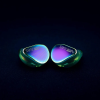Moondrop Echo-B
I assumed Echo-B was the dongle version of FreeDSP. I'll have to cut it open to verify if it's the same Synaptics (Conexant) CX31988 chip inside, but if it is, Moondrop has made some improvements on their FW/SW. When Echo-B is connected, the (Android) Moondrop Link app offers:
- 5x EQ presets: 'Normal', 'Bass+', 'Bass++', Sound stage+', 'Treble+'. As with Moondrop MAY IEM, the app does not show what the corresponding EQ filters are.
- 9x PEQ filters: Peak only but, unlike FreeDSP, it appears that Moondrop has lifted all the restrictions--whatever frequency, gain, Q-factor you enter, even with decimals, appears to be accepted, Link no longer protests... Now what actually happens under the hood has yet to be confirmed (measurements...).
- The preset/custom EQ "sticks": it is saved onto Echo-B chip, and will be applied to whatever you connect Echo-B to.
Moondrop Echo-A
This is the one I was the most curious about... mostly because of the advertised 32bits/384kHz, with no EQ. It did not look like any other Moondrop USB-C thingie except, perhaps Quark-2.
The Moondrop Link app completely ignores Echo-A, as in: "it doesn't exist". Nothing wrong with that, it is aligned with Moondrop description: Echo-A is a regular 3.5mm SE dongle, with mic. support (ADC). The "QR Code for APP download" in their marketing material is actually not present in the packaging (it is present on Echo-B card), so it must be an error... Or is it?
Echo-A actually has app support... 'TTGK Station' app sees it as a TTGK module, with a CB1200-AU DAC/ADC chip. So, Echo-A appears to be the dongle version of Moondrop Quark-2 IEM (same SoC) and, as with Quark-2, TTGK 'Walk Play' app gives access to:
- 8x EQ presets: PLUA (?), Pop, Rock, Vocal, Bass, Flat, Cinema, Game. Each preset can be viewed and modified in the PEQ section of the app.
- A "Custom" PEQ made of 8x Peak filters, with adjustable Freq., Q, and Gain. You can save, upload, share these customs filters from the app (saved locally or in the cloud).
- The preset/custom EQ "sticks": it is saved onto Echo-A SoC, and will be applied to whatever you connect Echo-A to.
On the other hand, TTGK Station sees Echo-B as a Moondrop product, lists all the USB interfaces, but that’s it: you can't configure anything with the 'Walk Play' app.
So, from a features stand point: Echo-A is 3.5mm dongle with mic. support and 8x PK filters configurable through TTGK 'Walk Play' app. Echo-B is a 4.4mm ("balanced", differential ) dongle with 9x PK filters configurable through Moondrop Link app.



